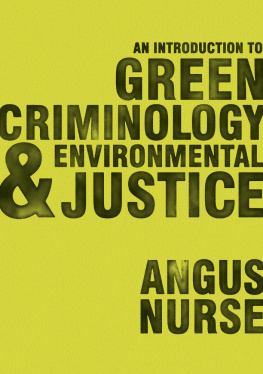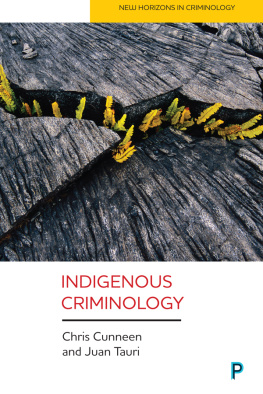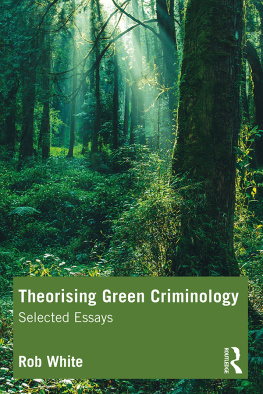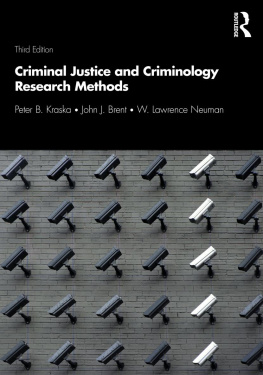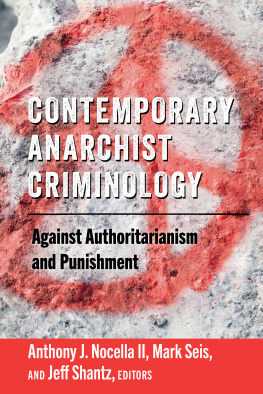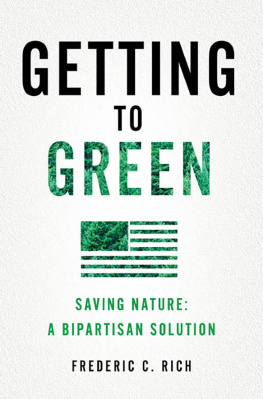SAGE Publications Ltd
1 Olivers Yard
55 City Road
London EC1Y 1SP
SAGE Publications Inc.
2455 Teller Road
Thousand Oaks, California 91320
SAGE Publications India Pvt Ltd
B 1/I 1 Mohan Cooperative Industrial Area
Mathura Road
New Delhi 110 044
SAGE Publications Asia-Pacific Pte Ltd
3 Church Street
#10-04 Samsung Hub
Singapore 049483
Angus Nurse 2016
First published 2016
Apart from any fair dealing for the purposes of research or private study, or criticism or review, as permitted under the Copyright, Designs and Patents Act, 1988, this publication may be reproduced, stored or transmitted in any form, or by any means, only with the prior permission in writing of the publishers, or in the case of reprographic reproduction, in accordance with the terms of licences issued by the Copyright Licensing Agency. Enquiries concerning reproduction outside those terms should be sent to the publishers.
Library of Congress Control Number: 2015940441
British Library Cataloguing in Publication data
A catalogue record for this book is available from the British Library
ISBN 978-1-47390-809-3
ISBN 978-1-47390-810-9 (pbk)
Editor: Amy Jarrold
Editorial assistant: George Knowles
Production editor: Sarah Cooke
Marketing manager: Sally Ransom
Cover design: Stephanie Guyaz
Typeset by: C&M Digitals (P) Ltd, Chennai, India
Printed and bound by CPI Group (UK) Ltd, Croydon, CR0 4YY
About The Author
Angus Nurseis Senior Lecturer in Criminology at Middlesex University School of Law where he teaches and researches criminology and law and is Programme Leader for the MA Criminology. Angus has research interests in green criminology, corporate environmental criminality, critical criminal justice, animal and human rights law and anti-social behaviour. He is particularly interested in animal law and its enforcement and the reasons why people commit environmental crimes and crimes against animals. Angus has also researched and published on the links between violence towards animals and human violence. His first book
Animal Harm: Perspectives on why People Harm and Kill Animals was published by Ashgate in 2013, his second;
Policing Wildlife: Perspectives on the Enforcement of Wildlife Legislation was published by Palgrave Macmillan in 2015.Angus is co-editor of Palgrave Macmillans
Palgrave Studies in Green Criminology book series (with Rob White from the University of Tasmania and Melissa Jarrell from Texas A & M University at Corpus Christi). Together with Becky Milne (University of Portsmouth) and Sam Poyser (Nottingham Trent University) he is currently working on a book on miscarriages of justice, a subject on which he has contributed to two essay collections from the Justice Gap.
Preface
This book developed to serve two disparate functions; first, the need for an introductory easily digestible text providing an introduction to the concepts of green criminology and environmental justice for both students and practitioners. Second, a research-based volume that provides discussion of contemporary issues and debates in green crime and environmental harm. The research on which this book is based has taken place over more than 15 years but is far from complete given ongoing developments in environmental crime policy and practice and in the field of environmental law and its enforcement.
Green crime is a fast-moving and somewhat contested area in which academics, policymakers and practitioners frequently disagree not only on how green crimes should be defined but also on: the nature of the criminality involved; potential solutions to problems of green crime; and the content and priorities of policy. Within ecological justice discourse, debates continue over whether green crimes are best addressed through criminal justice systems or via civil or administrative mechanisms. Indeed, a central discussion within green criminology is that of whether environmental harm rather than environmental crime should be its focus, with the environmental harm perspective currently dominating green criminological discourse. In essence, there is ongoing fundamental debate over whether green crimes should be seen as the focus of mainstream criminal justice and dealt with by core criminal justice agencies such as the police, or whether they should be considered as being beyond the mainstream. The argument for this harm perspective is dominated by the often transnational nature of environmental crimes, their location within government environmental policy departments rather than criminal justice ones and the fact that environmental harms are often dealt with by specialist environmental agencies (in)appropriately constituted (and resourced) to deal with the specifics of green offending. It should, however, be noted from the outset that much environmental harm is regulatory in nature rather than actually being categorized as crimes. Put another way, much of what we may think of as green crime is not in fact defined as crime and is dealt with other than by criminal justice agencies.
For those new to the field of green criminology these debates risk becoming a distraction from the core issues of understanding the current problems facing the environment and ecosystems and the manner in which justice systems deal with these. The purpose of this book is to provide an introduction to key concepts in green criminology and to discuss the nature of environmental harms (including crimes against animals) within a broad justice framework. However, it is also intended to provide for discussion of the complexities of contemporary harms and issues relating to illegal environmental activity. In particular, corporate environmental crime and the role of the state in dealing with transnational environmental crime and the use of civil and administrative law mechanisms where criminal justice processes prove ineffective. The central questions running through this book are a) how can a green perspective be applied to contemporary criminal justice? and b) how should distinctly green crimes be dealt with in order to both address offending behaviour and repair the harm caused by environmental offending?
While the focus of this text is predominantly on crime and criminality, it is not purely an environmental crime book. There are many excellent books that deal with transnational and environmental crime problems such as Situ and Emmons (2000) Environmental Crime; a text covering the context in which environmental crimes are dealt with by criminal justice systems and that helps define their nature. Rob Whites (2008)






